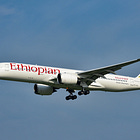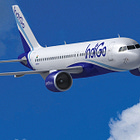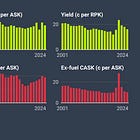Two years of Analytic Flying
Around this time last year we wrote an honest (and grumpy) review of our first year of Analytic Flying. We thought it would be good to mark our 2nd anniversary with a more sober review. Last year we implored ourselves to stop being so grumpy, so we hope that we’ve at least made a good effort to be more positive. Also, don’t worry, this year’s review won’t be as long and it certainly won’t be our Jerry Maguire moment!
Over the last year, we’ve published 43 articles. We had aimed for one a week but this wasn’t possible given the extensive time taken to produce long-form content and life getting in the way. We welcomed Analytic Flying Jnr in January and suffered the sudden loss of a parent a few months later. At times life was a distraction, and at other times Analytic Flying was a great distraction for us. Of the 43 articles, 15 were shorter “chart of the week” pieces with interesting data and less analysis.
We also promised a more global focus and we think we’ve delivered. Several articles over the last year focused entirely on non-Australian topics while others were global topics with relevance to contemporary issues in Australian aviation. In the former category, we spent some time looking at Air New Zealand’s fleet shortages and comparing the strategies behind the global connecting hubs. We delved into the Indian market, including extensive work on the A321XLR at IndiGo. One reason we’ve focused on India is its phenomenal growth, dynamism and potential!
In the later category, two recent analyses come to the fore. We used US data to compare the operating costs of regional and narrowbody jets, highlight how regional jets are misunderstood by the public, and how they wouldn’t have saved Bonza. We looked at the EU’s compensation scheme, showing how it generates obtuse incentives for airlines. We hope that it’ll help inform debate on the Aviation Consumer Ombuds Scheme.
This follows on from other novel analyses that included a comprehensive review of Emirates’s hub strategy, utilising their Australian network as an instructive example to explain how and why they’re willing (required?) to schedule flights with 18 hour turnarounds in Australia.
That said, our two most enjoyable analyses this year are two that also went relatively unnoticed, or at least didn’t garner nearly as much attention relative to the effort that went into them. This just reinforces the joy that we have gained working on Analytic Flying over the last two years!
The first of these analyses was a detailed tracking of Qantas’s fleet return after the COVID-19 pandemic. While the results may not have been earth shattering, it highlighted how aircraft availability was the real determinant of capacity. This database led to several follow-on analyses.
The second of these may have been our Jerry Maguire moment, albeit a subtle one. It focused on airline profitability and why being profitable isn’t good enough in a sector with unusually high capital costs. Hopefully it helped contextualise why the sector is relatively concentrated and why many new entrants will struggle and likely fail. They simply don’t have enough capital or alternatively poor margins and returns will undermine their ability to afford that capital when markets becomes more competitive.
What next?
We keep reminding readers that we do this because we enjoy it, and we have to say that we’ve really enjoyed the last year! Analytic Flying isn’t a business. There are no ads or credit card sign-up links on our website. We don’t begrudge websites that do, but this isn’t our vibe. Our funding model is simple: everything is free and we encourage readers to sign-up for a subscription to help us track impact.
Subscription is free, but we also have a voluntary paid subscription option for readers who would like to contribute to our running costs. Thank you to those who have signed-up for a paid subscription. We appreciate and value your support! Our model has constraints as it doesn’t afford us a professional staff to churn out high frequency content like short form news, proof read articles, or purchase access to industry databases. But we don’t think that that’s what you’re coming for!
Something that’s irritated us over the last few months is the increasing use of our content by other platforms, often without attribution. We’re don’t mean a linked reference to Analytic Flying (that’s really good actually), rather paraphrasing our work in other “original” content without attribution. Moreover, doing this with the explicit purpose of developing monetising content.
We’ve spoken to a few new media experts for advice. We don’t want to put Analytic Flying behind a paywall as this defeats the purpose of the project. Instead, we’re proposing an “ethical paywall”. It’s pretty simple: if you use Analytic Flying for work or any professional or commercial purpose then sign-up for a paid subscription. If it’s just personal use then carry on as you are, whether that be a free or paid subscription. An ethical paywall will hopefully ensure that important information remains accessible to the public for personal use.
While Analytic Flying isn’t a business, more paid subscriptions will allow us to do more. That includes more frequent and regular content, and utilising industry data in addition to publicly available data (these databases are very expensive). Many readers have also been encouraging use to develop alternative content streams like video content to podcasts, but these are well outside our capabilities at present.











